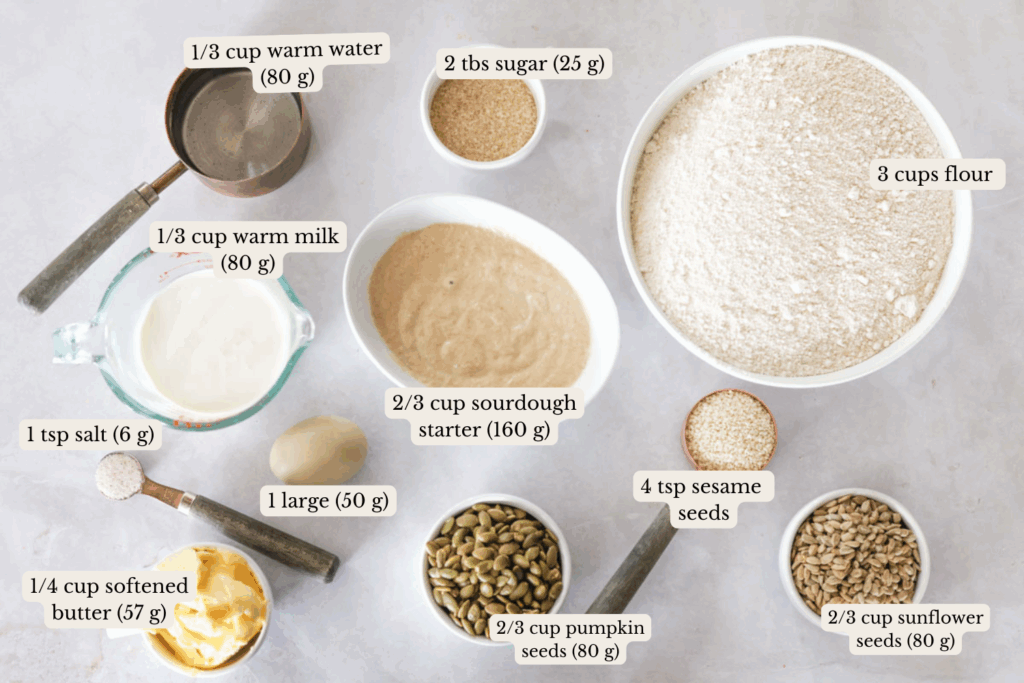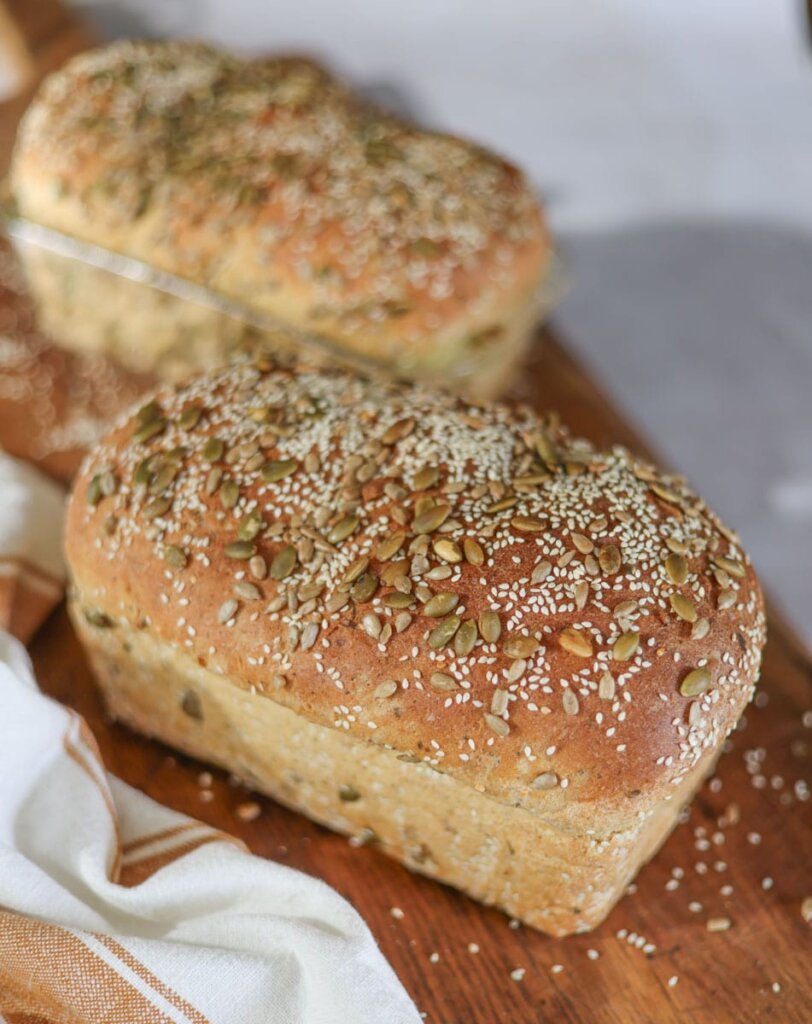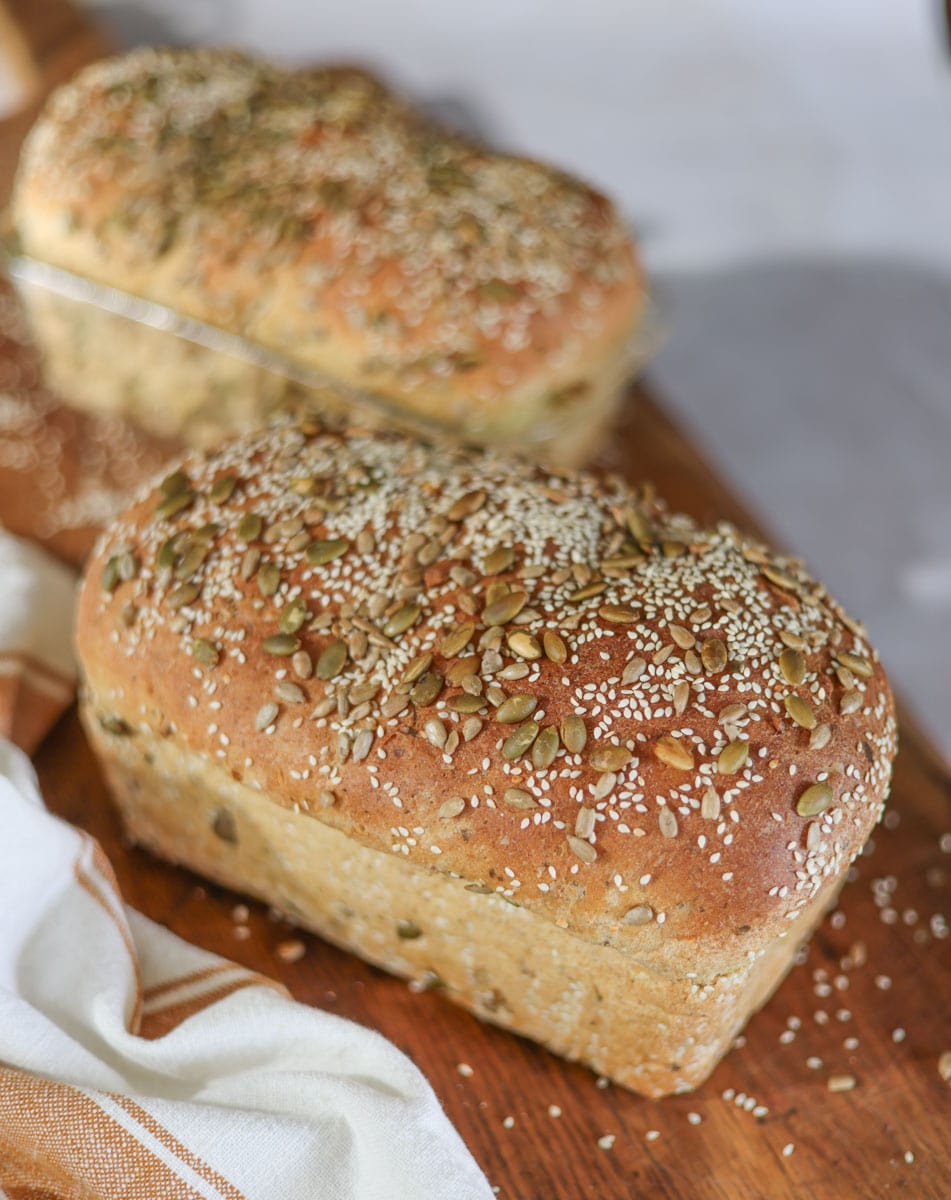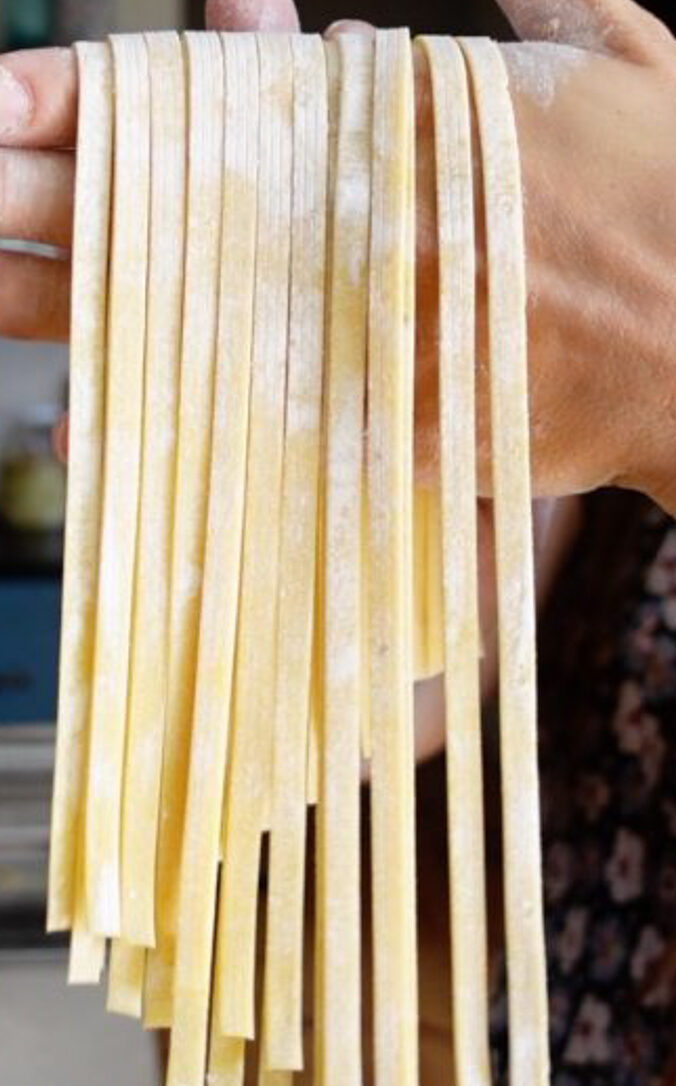Easy Seeded Sourdough Sandwich Bread Recipe
Seeded sourdough sandwich bread is soft and fluffy. It’ll please even the pickiest of eaters. This recipe includes starter, discard, and quick yeast versions.
I’ve always had a thing for hearty, earthy, seedy breads. However, my husband and kids have never shared that affection.
Recently, I realized that maybe their aversion to seedy breads isn’t necessarily thanks to the seeds, but rather to the density of the seeded breads you find in most stores or bakeries.
My husband and kids are not fans of hard, dense breads. They like soft, light, airy breads. So, I thought to myself, I will solve this great rift in my family over seeded breads by simply adding seeds to a softer, higher hydration bread dough to make soft, airy, seeded bread. Truly genius.
Just kidding, but anyway, my hypothesis worked. Making a soft, brioche style bread from freshly milled flour (optional) with added seeds was a crowd pleaser. I got my earthy, seedy bread and they got their soft, light, classic sandwich loaf.
And now, I share my soft seeded sandwich bread recipe with you. This seeded sourdough sandwich bread recipe can be made as a long fermented sourdough bread, a discard loaf, or a quick rise yeast bread with a few adaptations from the original sourdough recipe I share below.

If you prefer a video walkthrough, spend the day with me in my homestead kitchen baking Seeded Sourdough Sandwich Bread.
Why You’ll Love This Recipe
- Soft and airy texture: This isn’t your typical dense, chewy seeded loaf. The dough is enriched with butter, milk, and egg, giving it a soft, tender crumb that feels light without falling apart. It’s the kind of bread that works just as well for sandwiches as it does for a simple slice with butter. You can tear into it easily, and it toasts up beautifully without going dry.
- Nutritious seeds without the heaviness: You’ll get a solid dose of pumpkin, sunflower, and sesame seeds throughout the loaf and on top. But instead of weighing the bread down, these nutritious seeds are folded into a high-hydration, well-kneaded dough for structure. You get a loaf that has just enough texture to feel satisfying, but still soft and easy to eat.
- If you’re looking to mix in some healthy extras, consider adding a tablespoon of flax seeds or poppy seeds. These seeded sourdough sandwich bread offer more flavor and a nice crunch without messing with the rise. A teaspoon of fennel seeds works great too, giving a gentle, sweet hint that works well with the savory vibes.
- Flexible for your schedule: If you’re looking for a dough that plays nice with your timeline, look no further. You can make it as a long-fermented sourdough if you’ve got the time and crave that deep, complex flavor. But if you need a loaf of bread by dinner, it adapts easily into a quick-rise yeast loaf or a discard version with the addition of instant yeast.
- Works for more than just sandwiches: This is more than just a homemade seeded sourdough sandwich bread recipe. It’s a flexible dough that holds up to all kinds of uses. You can shape it into soft dinner rolls for soup night, bake it into burger buns for the coming weekend, or roll it out for cinnamon rolls when you want something sweet. I have a feeling you’ll come back to this recipe again…and again.
- Family-friendly taste: Even if some family members aren’t fans of seeds, this bread is sure to win them over. Its soft texture, hint of sweetness, and classic sandwich-loaf vibe make the seeds barely noticeable. It feels hearty without being overly “healthy,” striking the perfect balance that has everyone reaching for one more slice.
What You’ll Need
INGREDIENTS
For the Dough:
- 1/3 cup warm milk (80 g)
- 1/3 cup warm water (80 g)
- 2/3 cup sourdough starter (160 g)
- (Add 1 tablespoon instant yeast (7 g) if making as a discard recipe)
- 1 egg (50 g, large)
- 2 tablespoons sugar (25 g)
- 1/4 cup softened butter (57 g)
- 1 teaspoon salt (6 g)
- 3 cups flour (360 g, all-purpose)
- 1/3 cup pumpkin seeds (40 g)
- 1/3 cup sunflower seeds (45 g)
- 2 tablespoons sesame seeds (18 g)
Seed topping:
- 1/3 cup pumpkin seeds
- 1/3 cup sunflower seeds
- 18 g sesame seed (2 tablespoons)

TOOLS:
- Large mixing bowl or stand mixer
- Kitchen scale (recommended)
- Loaf pan (9×5”)
- Pie plate (for seed mix)
- Kitchen towel

Step-by-Step Instructions:
- Add all ingredients into a large bowl or the bowl of a stand mixer.
- Mix just until you get a shaggy dough. It won’t be smooth yet, and that’s totally fine.

- Knead the dough thoroughly for 5-10 minutes until it is smooth and workable, but still a bit sticky.
- Shape the dough into a large ball, place it in a greased bowl, and cover with a damp towel. Set in a warm place to bulk proof, and keep an eye on the top of the dough to see when it has doubled in size.

- Punch the proofed dough down, then shape it into a loaf.

- Mix the extra seeds in a pie plate, then roll the shaped dough in the seed mix, pressing gently to coat the surface of the dough evenly.

- Place the seed-covered, shaped dough in a greased, standard loaf pan, cover with a damp tea towel, and set in a warm place for the final proof until it is doubled in size.
- Bake at 375 for 30 minutes.

FAQ
How do I make this a discard recipe?
I’m a big fan of using my own sourdough starter for breads like this, but you can easily turn it into a discard loaf. You do this by mixing in 1 tablespoon of instant yeast with the dough and skipping the long fermentation. Let the dough rise until it doubles in size for both the bulk rise and final proof. Depending on your kitchen’s temperature, it usually takes 1-2 hours per rise to get nicely risen dough.
Can I swap out the seeds for a different combination of seeds?
Yes, you can mix and match seeds or adjust amounts to keep everyone’s taste buds happy. This recipe uses pumpkin, sunflower, and sesame seeds for a great blend of crunch and flavor, but there are endless combinations of seeds to try. Flax, chia, poppy, fennel, or hemp seeds work well too. Just keep the total amount similar to maintain the dough’s texture. For smaller seeds like chia or flax, use a bit less to avoid drying out the dough.
What do I do if I don’t have a stand mixer?
You certainly can knead the dough by hand. Initially, the wet dough turns into sticky dough because of its high hydration and rich ingredients, but it gets smoother the more you work it. This is where a bench scraper comes in handy. Another idea is to try brief kneading sessions with pauses, like the stretch-and-fold method.
Can I use freshly milled, whole wheat, or bread flour in this recipe?
Yes, this recipe is flexible and works well with freshly milled flour, whole wheat flour, or bread flour. Whole wheat flour will give you a heartier, more traditional whole wheat bread. White flour keeps the loaf soft and light, and bread flour adds a bit more chew and structure. For the best results, start by swapping in 25–50% of the flour you’re experimenting with to keep the texture balanced. Additionally, no matter the flour mix, you’ll still end up with a flavorful, delicious bread.
Tips
- This dough will be quite sticky at first, and that’s normal. Resist the urge to add a lot of extra flour right away. With enough kneading and a bit of rest, the dough becomes noticeably smoother and easier to handle.
- Use a stand mixer to make the kneading process easier and more consistent, especially with a high-hydration dough like this one.
- If it still feels too sticky after kneading thoroughly, let the dough rest for half an hour. Then, knead again to reassess the texture. Only add extra flour 1/4 cup at a time and only if the dough really needs it.
- Roll the shaped loaf in seeds to add flavor and texture to every bite. Also, lightly brush the loaf with water or milk before rolling in the seed mixture to help the seeds stick better
- If you’re not sure your loaf is fully done on the inside, stick a kitchen thermometer through the center. A finished loaf will register around 190°F in the center.
Storage
To begin with, you can keep your loaf in a sealed bag at room temperature for up to 3 days. Put it in a reusable bread bag, airtight container, or even a large zipper bag to keep it from drying out. On the other hand, avoid storing the bread in the fridge, as that can dry the bread out faster than room temperature.
For longer storage, slice the loaf once it’s fully cooled and put the slices in a freezer-safe bag or container. Moreover, you can freeze the whole loaf unsliced too, but pre-slicing makes it easier to pull out just what you need. Pop slices in the toaster straight from the freezer for an easy, warm slice whenever you want it.

Easy Seeded Sourdough Sandwich Bread Recipe
Ingredients
Method
- Add all ingredients into a large bowl or the bowl of a stand mixer.
- Mix just until you get a shaggy dough. It won't be smooth yet, and that’s totally fine.
- Knead the dough thoroughly for 5-10 minutes until it is smooth and workable, but still a bit sticky.
- Shape the dough into a large ball, place it in a greased bowl, and cover with a damp towel. Set in a warm place to bulk proof, and keep an eye on the top of the dough to see when it has doubled in size.
- Punch the proofed dough down, then shape it into a loaf.
- Mix the extra seeds in a pie plate, then roll the shaped dough in the seed mix, pressing gently to coat the surface of the dough evenly.
- Place the seed-covered, shaped dough in a greased, standard loaf pan, cover with a damp tea towel, and set in a warm place for the final proof until it is doubled in size.
- Bake at 375 for 30 minutes.
Nutrition
Video
Notes
Tips
- This dough will be quite sticky at first, and that’s normal. Resist the urge to add a lot of extra flour right away. With enough kneading and a bit of rest, the dough becomes noticeably smoother and easier to handle.
- Use a stand mixer to make the kneading process easier and more consistent, especially with a high-hydration dough like this one.
- If it still feels too sticky after kneading thoroughly, let the dough rest for half an hour, then knead again. Only add extra flour 1/4 cup at a time and only if the dough really needs it.
- Roll the shaped loaf in seeds to add flavor and texture to every bite. Also, lightly brush the loaf with water or milk before rolling in the seed mixture to help the seeds stick better
- If you’re not sure your loaf is fully done on the inside, stick a kitchen thermometer through the center. A finished loaf will register around 190°F in the center.
Storage
- You can keep your loaf in a sealed bag at room temperature for up to 3 days. Put it in a reusable bread bag, airtight container, or even a large zipper bag to keep it from drying out. Avoid storing the bread in the fridge, as that can dry the bread out faster than room temperature.
- For longer storage, slice the loaf once it's fully cooled and put the slices in a freezer-safe bag or container. You can freeze the whole loaf unsliced too, but pre-slicing makes it easier to pull out just what you need. Pop slices in the toaster straight from the freezer for an easy, warm slice whenever you want it.





